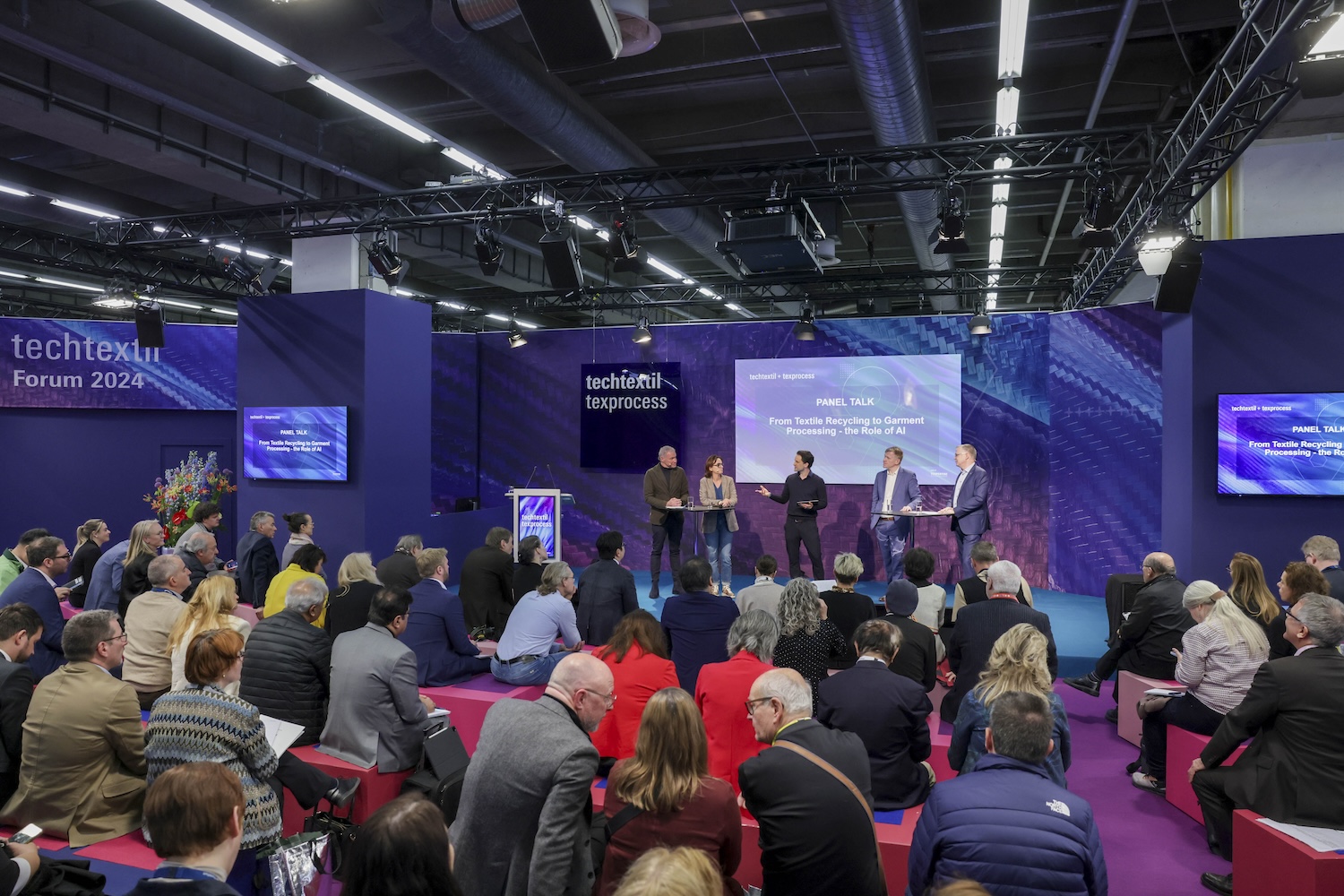
Changing the world with textile innovations
Innovation in Textiles’ Marie O’Mahony talks to the new Show Director of Techtextil and Texprocess.
29th May 2024
Innovation in Textiles
|
As Techtextil and Texprocess celebrates a milestone edition, Sabine Scharrer has taken the helm. Meeting her at the show, Marie O’Mahony took the opportunity to get her take on the fair’s evolution, looking at some of the current and future trends and focus areas.
Marie O’Mahony (M. O’M): Thank you for taking the time to give this interview Sabine. Although you have been with Messe Frankfurt GmbH for 27 years, this is your first Techtextil/Texprocess in Frankfurt as Show Director. As the event celebrates its 20th anniversary, what do you see as the key to its longevity?
Sabine Scharrer (S.S): Personal encounters are valued more than ever today. Trade fairs are essential for business contacts, sales success, industry exchange and information for companies worldwide. At Techtextil and Texprocess, we support companies on their way into the future. The leading trade fairs reflect the enormous global innovative strength of the industries. Many developments are presented to the global public for the first time here. These textile innovations are important game changers for many other industries. Participants will find the right partners and solutions to make their companies fit for the future.
What is special about Techtextil is that it covers a globally unique spectrum. From textile production machinery to fibres and yarns, technical textiles, nonwovens, coated textiles, functional apparel textiles and smart textiles. This gives visitors a unique overview of the global industry. Techtextil offers solutions for all industries in twelve application areas - from products for the medical sector to developments for shoe or clothing production or architecture. Visitors to Techtextil will find highly customised solutions for their specific application. This is what makes these leading trade fairs so attractive and explains the key to their longevity.
M. O’M: There has been a huge growth in online events, how is this influencing or impacting Techtextil/Texprocess? Are we likely to see a move towards an online or hybrid event in 2026?
S. S: The focus remains on personal encounters and direct dialogue on site. These trade fairs offer immense onsite benefits, such as a global overview of trends and innovations in just a few days and chance encounters that often lead to important business contacts. Techtextil and Texprocess are important business meeting points for various industries, where forward-looking developments find the right partners.
Techtextil creates unique synergies and enables efficient business success for global industries by bringing together buyers, manufacturers and suppliers in one place and at one time. Texprocess, which takes place at the same time, perfectly complements this offer. While digital tools complement trade fair preparation and follow-up and thus networking at trade fairs, Messe Frankfurt's experience shows that direct, face-to-face interaction is still seen as invaluable and that personal encounters and business contacts cannot be transferred to the digital world.

M. O’M: Artificial Intelligence (AI) was a key theme across both platforms. What differences are you seeing between the way that fibre and fabric manufacturers exhibiting at Techtextil are using AI (or planning to use it), and the approach of textile machine manufacturers exhibiting at Texprocess?
S. S: Artificial intelligence (AI) was a key topic at Techtextil and Texprocess. Fibre and fabric manufacturers exhibiting at Techtextil are using AI to improve material development and quality control, for example. They use AI-supported analyses to develop new materials that meet specific requirements.
Textile processing machinery manufacturers at Texprocess, on the other hand, are focusing on the use of AI to automate and optimise their machines. Their approach is aimed at increasing the efficiency and precision of production systems. AI is used to make machines smarter so that they can monitor themselves and predict maintenance requirements, among other things.
M. O’M: Data protection is a big concern around AI. Do you see the smart and advanced textile industry taking steps to protect themselves?
S. S: Data privacy is a major concern in the context of artificial intelligence (AI) and the advanced textile industry is increasingly taking measures to protect itself. It is recognised that some companies are increasingly turning to data protection policies and technologies to ensure the security of sensitive data. This includes, for example, the implementation of encryption technologies and strict control of data access.
M. O’M: With upcoming legislative requirements as part of the EU strategy for sustainable textiles have you seen the industry stepping up to this, particularly around the difficult issue of recycling? Do you see a role in this for AI?
S. S: Yes, the industry is taking significant steps in view of the upcoming legal requirements as part of the EU strategy for sustainable textiles. The transition to a sustainable future will be significantly shaped by digitalisation, automation and artificial intelligence. Regulations such as the EU Sustainable and Circular Textiles Strategy require a high level of digitalisation. These technologies support fulfilling sustainability requirements of customers and partners, for example by ensuring greater transparency in the supply chain and more efficient use of resources.
The latest developments in technologies and machines are presented at Techtextil and Texprocess. Highlights included intelligent systems that use AI to analyse fashion trends, detect errors through image analysis and sort used clothing. In the latter case, it became clear that AI plays a crucial role in overcoming recycling challenges and fulfilling legal requirements.
M. O’M: The enthusiasm for biomaterials shows little sign of abating, and there was no shortage of new developments at Techtextil. Is this prompting new developments in textile machinery? A second question, perhaps related, are we starting to see manufacturers achieve scale?
S. S: The topic of sustainability plays a central role and is therefore also relevant for new developments in materials and textile machine construction. At both trade fairs, sustainable exhibitors presented innovative solutions and technologies for environmentally friendly and resource-saving production processes in the textile industry. These exhibitors showed, for example, advanced machines and processes that enable energy efficiency and material savings, as well as solutions for waste reduction and recycling.
The presence of sustainable exhibitors emphasises the industry's growing awareness of environmental protection and sustainable development. Over 160 exhibitors have had their sustainability standards assessed in the areas of Sustainable Supply Chain, Materials & Processes and Strategy & Innovation and have been included in our Econogy Finder. They offer the industry the opportunity to make its production more sustainable and meet the growing demands of consumers and legislators.
M. O’M: New developments in smart fibres and textiles were very much in evidence once again. There were some examples of Printed Electronics (PE) and Flexible Hybrid Electronics (FHE), do you see this as a growth area for the show?
S. S: Smart fibres and textiles are an important part of the Techtextil and are increasingly seen as a growth area. This is particularly evident in the current developments in printed electronics (PE) and flexible hybrid electronics (FHE). These technologies make it possible to equip textiles with integrated electronic functions, which opens up a wide range of applications in areas such as health, sport and fashion.
Companies such as MCVE Technologie and AQ-Tech SAS are excellent examples of how innovation is being driven in this sector. The increasing presence of such companies at the fair and related talks in our Forum programme emphasises the importance and potential of this market.
M. O’M: The leading German universities and research institutes were all present and showcasing their work at Techtextil/Texprocess. Correct me if I am wrong, but there seemed to be fewer exhibitors from this sector from other countries. Why do you think this is and will you be planning any special section or strategies to encourage more to exhibit in 2026?
S. S: German universities and research institutes were strongly represented at Techtextil and Texprocess. One reason for this is, for example, the long tradition of German textile research. However, numerous international universities and research institutes were also present at the trade fairs – mostly presenting themselves in their country pavilions. With presentations for example from Belgium, China, France, India, UK or Switzerland we welcomed research institutes from all over the world. Also, in the future it is our aim to bring together all relevant players as it comes to research and education at our shows and do thus offer special support to universities to present themselves.
M. O’M: Attracting and retaining talent is a perennial issue for the industry. Do you see a role for Techtextil/Texprocess in helping to facilitate this? Are you planning any special initiatives in this for 2026?
S. S: This year, we dedicated the last day of the fair to young professionals. As part of the concept, students of selected universities were invited to visit the events. Many renowned institutes had already agreed in advance to attend the fairs with students from the relevant disciplines. The focus was on providing information on training and the courses of study and further education formats in order to address the needs of students and career starters. These knowledge and networking formats specifically addressed newcomers to the industry and offered recruiting companies the opportunity to familiarise themselves with the topics and motivation of the younger generation and to network. Another highlight of Young Professionals Friday was the presentation of the results of the Masterclass Performance Fashion Design - a 5-day workshop that brought together fashion students, manufacturers of functional apparel textiles and suppliers of processing technologies.
Due to the positive response, we are planning further initiatives for 2026 to support and train young professionals and counteract the shortage of skilled labour.
M. O’M: Which were the key markets by application sector attending Techtextil/Texprocess 2024, and does this indicate any trend shifts from the previous show?
S. S: At Techtextil and Texprocess 2024, the most important markets were primarily industrial applications, the garment and sports industry followed by medical applications and personal protection equipment. Growing sectors were ecological applications and the automotive industry. In the fields of sewing technology and cutting solutions, Texprocess offered the world's most comprehensive range of suppliers presenting pioneering solutions for efficient and advanced manufacturing processes. The major applications are all sectors of the garment industry but also Texprocess realises a growth of interest in the automotive and transportation sector.
M. O’M: I’m sure that you are already planning Techtextil/Texprocess 2026, are there are new initiatives that we should look out for? A spoiler alert if you like!
S. S: For Techtextil and Texprocess 2026, you can look forward to exciting initiatives, especially in the field of artificial intelligence (AI) and sustainability. We are planning innovative programmes that highlight the role of AI in advancing the textile industry and the importance of sustainable materials or recycling practices. Stay tuned for more details as we move forward with preparations for the next Techtextil and Texprocess!
M. O’M: Thank you for your time and insights here Sabine, it has been very interesting and valuable to have such a broad perspective on the sector.

Business intelligence for the fibre, textiles and apparel industries: technologies, innovations, markets, investments, trade policy, sourcing, strategy...
Find out more